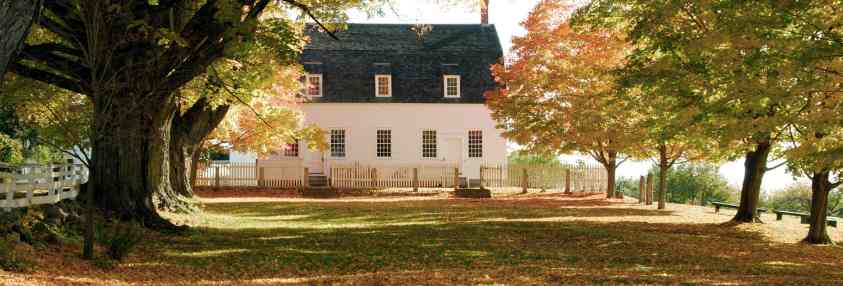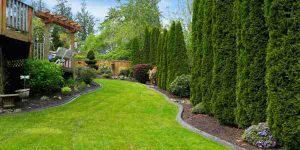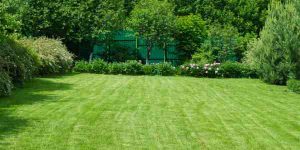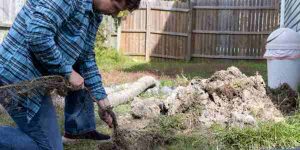The Signs of Thatch Buildup

The Signs of Thatch Buildup: How to Recognize When Your Lawn Needs Dethatching in the Fall
A beautiful, healthy lawn is a source of pride for homeowners. It’s a place for relaxation, outdoor activities, and creating lasting memories. However, even the most meticulously maintained lawns can develop issues over time, and one common problem is thatch buildup. Recognizing the signs of thatch accumulation is vital for maintaining a vibrant lawn. In this blog, Impact Landscapes will guide you through the indicators that your lawn may require dethatching, with a particular emphasis on tackling this task during the fall season.
Understanding Thatch Buildup
First, let’s clarify what thatch is. Thatch is a layer of dead grass, roots, and organic matter that accumulates on the soil’s surface, just above the grass’s root zone. In small quantities, thatch can be beneficial, providing insulation and protection to the soil. However, when it accumulates excessively, it becomes problematic.
Signs of Thatch Buildup
Thatch buildup can stifle your lawn’s growth and health. Here are the telltale signs that your lawn might be suffering from excessive thatch:
Spongy Lawn: One of the earliest indicators is the spongy or soft feeling when you walk on the lawn. Thatch can make the surface uneven and create a “bouncy” effect.
Reduced Water Infiltration: Thatch impedes water from reaching the soil and roots. If you notice that water pools on the lawn’s surface rather than being absorbed, it may be a sign of thatch buildup.
Shallow Roots: Healthy grass usually has deep, strong root systems. If your grass appears to have shallow or weak root systems, thatch could be inhibiting root growth.
Sparse Growth: You may observe areas of your lawn thinning out or appearing patchy. Thatch can hinder the emergence and growth of grass blades, resulting in sparse patches.
Discolored Patches: Sections of your lawn may exhibit a different color or texture compared to the rest. This can be due to thatch restricting nutrient absorption and water retention.
Slow Recovery: Lawns with excessive thatch tend to recover slowly from stressors such as heavy foot traffic or mowing. If your lawn seems sluggish in bouncing back, thatch might be the culprit.
The Impact of Thatch Buildup
Thatch accumulation can negatively affect your lawn’s overall health in various ways:
Impaired Water and Nutrient Absorption: Thatch creates a barrier, preventing water, nutrients, and air from reaching the soil and roots. This can lead to nutrient deficiencies and water stress for your grass.
Susceptibility to Disease and Pests: Thatch provides a cozy environment for pests and pathogens, making your lawn more susceptible to infestations and diseases.
Soil Compaction: The weight of the thatch layer can lead to soil compaction, inhibiting root growth and making it harder for grass to establish a strong foothold.
Stunted Growth: Thatch accumulation restricts the growth of grass blades, causing your lawn to appear weak and uneven.
Dethatching in the Fall: The Solution
Recognizing the signs of thatch buildup is the first step in addressing the issue. If your lawn displays these indicators, it’s time to consider dethatching. Dethatching is the process of removing the excessive thatch layer, allowing your lawn to breathe, absorb nutrients, and thrive once again.
Why Choose Fall for Dethatching
The fall season is the ideal time for dethatching your lawn. Here’s why:
Active Growth: During the fall, grass is in its active growth phase, which means it can recover quickly from the dethatching process.
Cooler Temperatures: Fall provides cooler and more favorable temperatures for lawn work. It’s less stressful for the grass than the hot summer months.
Less Stress on Your Lawn: Dethatching can be a bit stressful for the grass. Performing it in the fall ensures your lawn has ample time to recover before the winter season.
Professional Dethatching Services
For extensive thatch issues or larger lawns, professional dethatching services in the fall are a convenient and effective option. Experienced professionals can assess the condition of your lawn, determine the appropriate dethatching method, and execute the process efficiently.
In conclusion, recognizing the signs of thatch buildup is essential for maintaining a healthy and vibrant lawn. Thatch can impede water infiltration, nutrient absorption, and root growth, leading to a range of problems from stunted growth to increased pest activity. Dethatching is the solution, and fall is the best time to undertake this task. Whether you choose to dethatch your lawn manually or seek professional assistance, addressing thatch buildup in the fall will help your lawn regain its vitality and ensure a lush and resilient outdoor space for years to come. At Impact Landscapes, we are committed to helping you achieve a healthy and thriving lawn. Contact us to schedule your fall dethatching services and embrace the upcoming season with confidence and a revitalized lawn.



